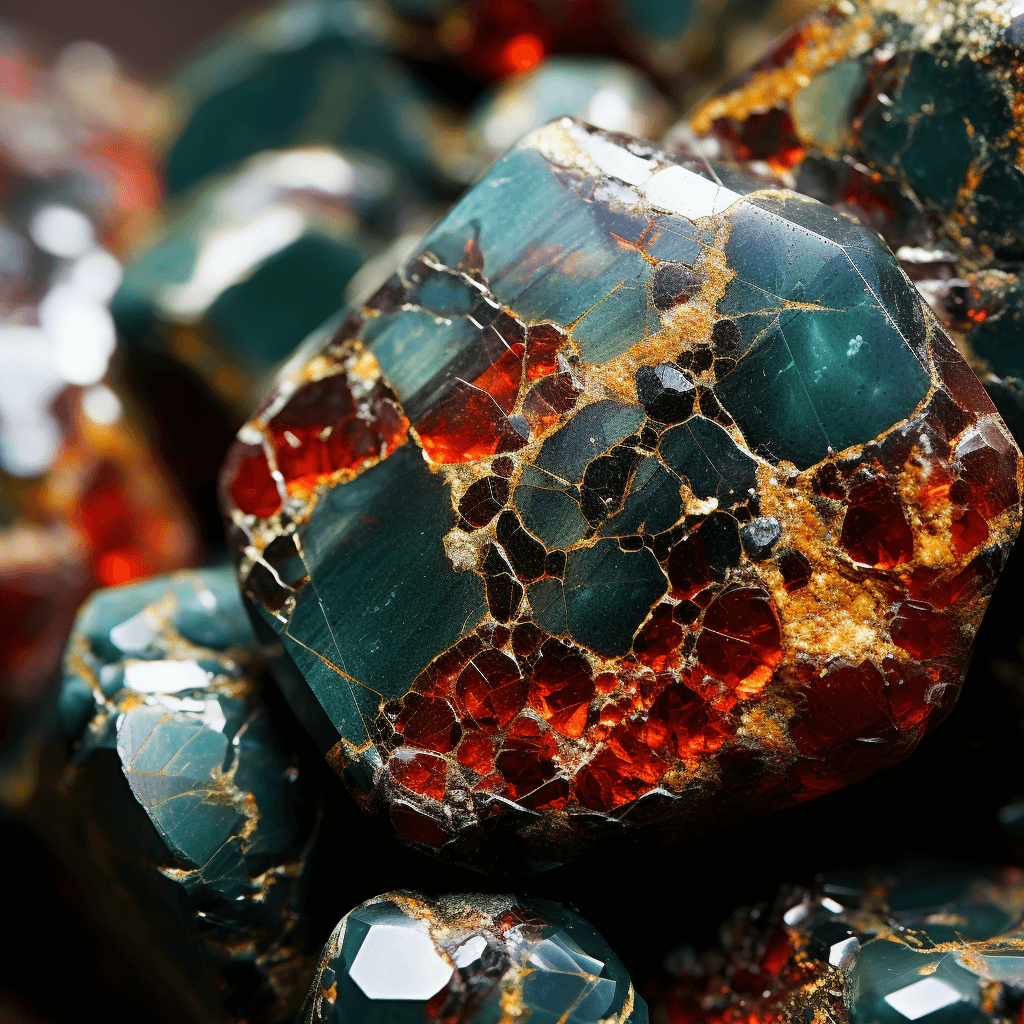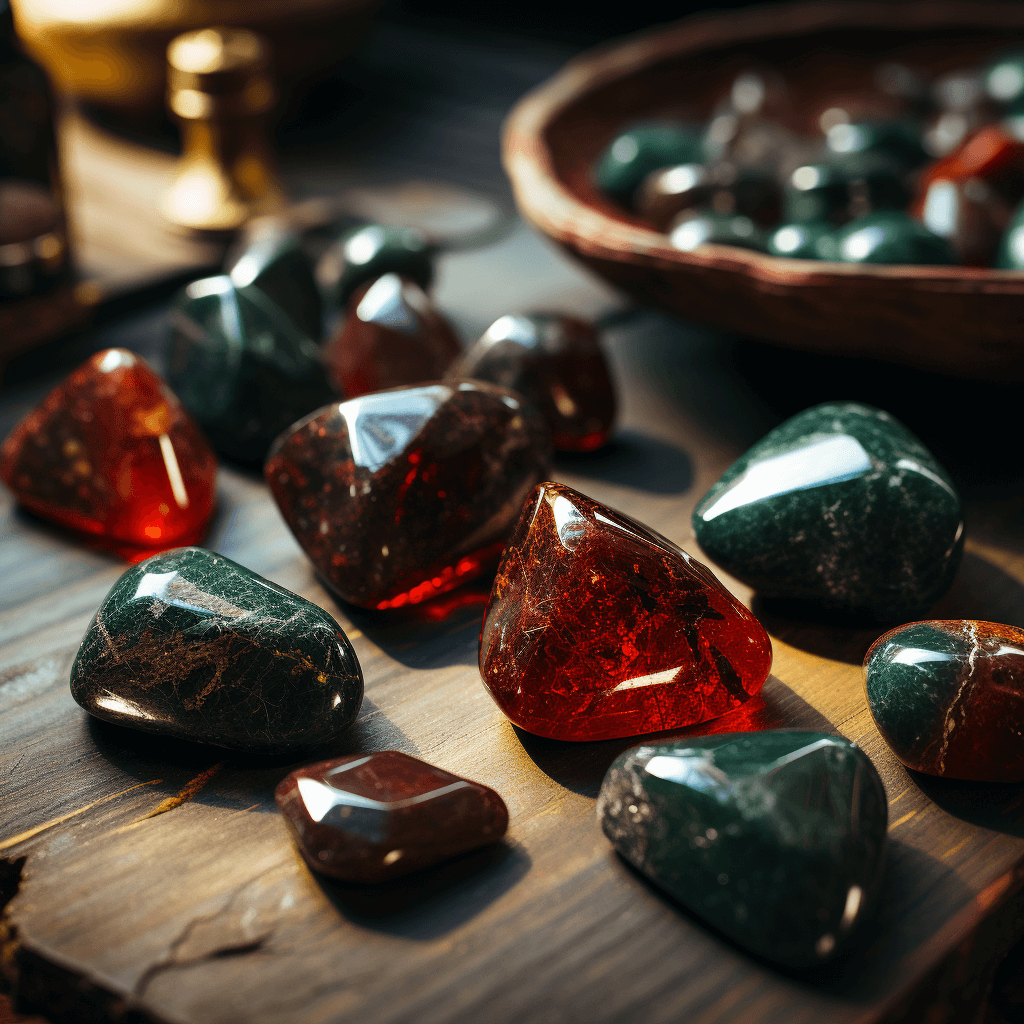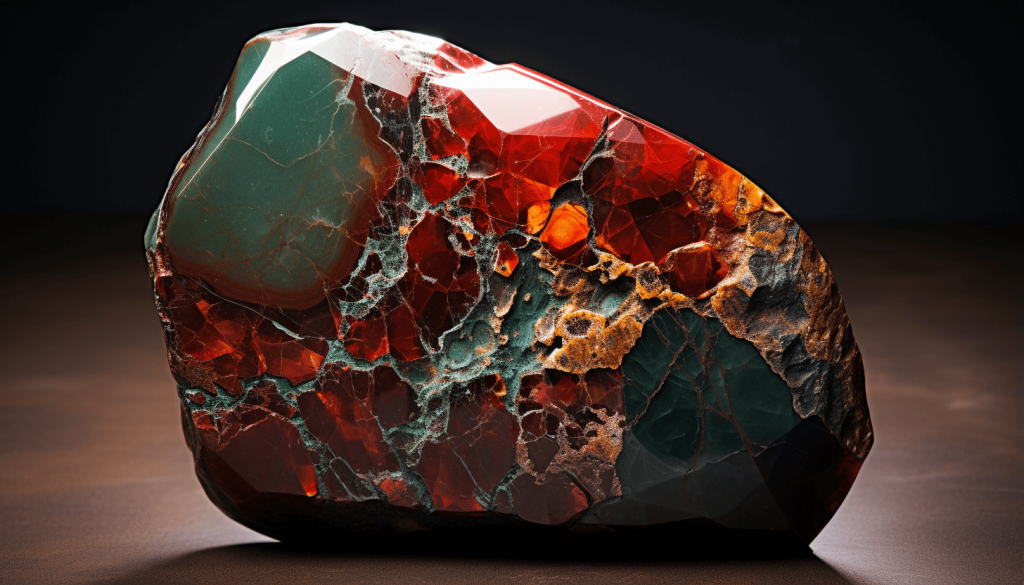Bloodstone, often referred to as the Ancient Warrior Stone, is a unique gemstone characterized by its deep green hue sprinkled with vibrant red spots. Historically revered for its mystical and healing properties, Bloodstone has been a symbol of courage and strength for warriors across different cultures.
Introduction to Bloodstone: The Ancient Warrior Stone
Throughout history, gemstones have been attributed with various meanings and powers. Among these, Bloodstone stands out not only for its captivating appearance but also for its rich historical significance. This stone, with its deep green base and distinctive red speckles, has been a beacon of valor and bravery.
Its name, which vividly describes its appearance, is deeply rooted in ancient lore. Legends state that the red spots on the Bloodstone were believed to be the blood of warriors, symbolizing their sacrifices and undying spirit. This association with warriors and battles has earned it the title of the Ancient Warrior Stone.
But beyond its martial associations, Bloodstone has also been cherished for its supposed healing properties. Ancient civilizations believed that this gem could purify the blood, boost energy, and even grant invisibility. While modern science might not support all these claims, the allure and fascination surrounding Bloodstone remain undiminished.
Today, Bloodstone continues to be a sought-after gemstone in jewelry and healing circles. Its vibrant colors and storied past make it a favorite for those seeking a connection to ancient wisdom and the warrior spirit.
Geological Formation and Properties of Bloodstone
Bloodstone, also known as heliotrope, is a captivating gemstone known for its deep green color with red speckles resembling drops of blood. This unique appearance has not only made it popular in jewelry but also steeped it in folklore and legends. From a geological perspective, understanding its formation and properties provides a deeper appreciation for this intriguing stone.
| Feature | Description |
|---|---|
| Mineral Class | Chalcedony (a type of Quartz) |
| Color | Deep green with red, orange, or brown spots |
| Hardness | 6.5 – 7 (Mohs Scale) |
| Luster | Waxy to vitreous |
| Transparency | Opaque |
| Crystal System | Hexagonal |
| Formation | Formed from volcanic activity or changes in sedimentary rock |
| Refractive Index | 1.530 – 1.539 |
| Specific Gravity | 2.58 – 2.64 |
The red speckles in Bloodstone are typically due to the presence of iron oxide, while the green color is attributed to chlorite or hornblende inclusions. Its formation is closely tied to volcanic activities or transformations in sedimentary rocks, making each piece a testament to the dynamic processes of our Earth.
Historical and Practical Uses of Bloodstone: From Ancient Amulets to Modern Applications

The allure of the Bloodstone extends far beyond its captivating appearance. Throughout history, this gemstone has been revered for both its mystical properties and practical applications. Its deep green hue, punctuated by red speckles, has made it a symbol of life force, bravery, and vitality in various cultures.
Ancient Civilizations and Bloodstone
In ancient times, Bloodstone was often used as an amulet or talisman, believed to protect warriors in battle and heal injuries. The ancient Greeks and Romans wore it as an emblem of courage, with many soldiers carrying engraved Bloodstones into battles. They believed that the stone could stop bleeding and heal wounds, attributing its red speckles to the blood of fallen warriors.
Middle Ages and Renaissance
During the Middle Ages, Bloodstone held a place of prominence in Christian lore. It was said that the red speckles on the stone were formed from the blood of Jesus Christ when it dripped onto green jasper during the crucifixion. As a result, the stone was used in sculptures and jewelry pieces depicting religious themes.
Modern Applications
Today, while the mystical beliefs surrounding Bloodstone have waned, its appeal remains undiminished. It’s popularly used in jewelry, especially in rings, pendants, and earrings. Beyond aesthetics, Bloodstone is also used in crystal therapy, believed to enhance vitality, boost immunity, and cleanse the blood. Some even use it as a grounding stone, helping to anchor individuals in the present moment and dispel confusion or negativity.
Bloodstone, due to its historical significance, is also known as the “Martyr’s Stone.” It’s believed to have been used to depict the martyrdom of saints and other religious figures in ancient art pieces.
Metaphysical, Healing, and Spiritual Properties of Bloodstone: Connection to Chakras
The Bloodstone is not just a gem of physical beauty; it’s also deeply rooted in metaphysical, healing, and spiritual realms. For centuries, individuals have turned to this stone for its purported abilities to heal, protect, and connect with the spiritual world.
Metaphysical Properties
Bloodstone is often regarded as a stone of transformation. It’s believed to assist in guiding one through changes and challenges, providing the strength to persevere and adapt. Many also consider it a stone of purity, helping to cleanse the aura and rid the mind of negative thoughts or energies.
Healing Abilities
From a healing perspective, Bloodstone is said to be particularly potent. It’s often associated with enhancing the circulatory system, detoxifying the blood, and supporting liver functions. Additionally, its grounding properties can help individuals cope with feelings of overwhelm, anxiety, or fatigue, bringing about a sense of calm and balance.
Spiritual Connection and Chakras
The spiritual significance of Bloodstone is closely tied to the body’s chakra system. Predominantly, it’s connected to the Root Chakra (or Base Chakra), which is the foundation of the body’s energy system. By aligning and activating this chakra, Bloodstone helps anchor the spirit, fostering feelings of safety and grounding. Moreover, its ties to the Heart Chakra emphasize love, compassion, and emotional healing. By balancing these chakras, Bloodstone aids in harmonizing the mind, body, and spirit, paving the way for spiritual awakening and growth.
The Root Chakra, also known as Muladhara in Sanskrit, is symbolized by the color red, mirroring the red speckles of Bloodstone. This chakra is the foundation of our survival instincts, governing feelings of security, stability, and basic needs.
Caring for and Crafting with Bloodstone: Jewelry and Artistic Designs – What NOT to do
Bloodstone, with its rich history and deep metaphysical significance, is a gemstone that many cherish. Whether it’s set in a piece of jewelry or used in artistic designs, proper care is essential to maintain its beauty and integrity. Moreover, when crafting with this stone, there are certain practices to avoid ensuring its longevity and preserving its natural allure.
Caring for Bloodstone
Like all gemstones, Bloodstone requires gentle care to keep it looking its best. Here are some guidelines and things to avoid:
- Avoid Harsh Chemicals: Never clean Bloodstone with harsh or abrasive chemicals. Instead, use a soft cloth and mild soapy water.
- Keep Away from Extreme Heat: Sudden temperature changes can damage the stone. It’s best to keep it away from direct sunlight for prolonged periods or other sources of intense heat.
- Store Separately: To prevent scratches, store Bloodstone separately from other jewelry, preferably in a soft pouch or lined jewelry box.
Crafting with Bloodstone
When incorporating Bloodstone into jewelry or artistic designs, it’s crucial to handle it with care and be aware of the following:
- Avoid Thin Settings: Given its relative hardness, Bloodstone can be prone to chipping. Avoid designs that leave the edges of the stone too exposed or thin.
- Limit Mechanical Tools: When shaping or setting the stone, minimize the use of mechanical tools that can generate heat or put undue pressure on the stone.
- Consider the Stone’s Natural Patterns: Bloodstone’s beauty lies in its unique patterns. When crafting, consider these natural designs and work to enhance, not overshadow, them.
Bloodstone, due to its unique patterns and colors, is often used in cameos and intaglios. These artistic carvings require a keen eye and a gentle hand to ensure the stone’s natural beauty shines through.
Understanding Bloodstone’s Distinctive Red Speckles
The Bloodstone, as its name suggests, is renowned for its distinctive deep green hue interspersed with red speckles. These speckles, reminiscent of droplets of blood, are not just a visual marvel but also carry significant geological and historical weight. Let’s delve deeper into the origin and significance of these red inclusions.
Geological Origin of the Red Speckles
The primary component of Bloodstone is green chalcedony, a type of microcrystalline quartz. The red speckles, which give the stone its iconic appearance and name, are typically due to the presence of iron oxide, specifically hematite. These inclusions form during the stone’s creation, as minerals interact and bond within the host rock. The varying concentration and distribution of these iron oxide inclusions can lead to different patterns and intensities of red within each Bloodstone, making each piece unique.
Symbolism and Historical Significance
The red speckles have been a source of fascination and reverence for centuries. In ancient times, these markings were often associated with the blood of warriors or revered figures, leading to the stone’s use as a talisman for protection and bravery. As mentioned earlier, during the Middle Ages, the red inclusions were linked to the blood of Christ, adding a layer of religious significance to the stone.
Impact on Value and Aesthetics
From a gemological perspective, the distribution, intensity, and clarity of the red speckles can influence the value of a Bloodstone. Stones with clear, vibrant, and well-distributed red inclusions are often considered more valuable. However, personal preference plays a significant role in the stone’s appeal. Some individuals might prefer a piece with more subtle speckles, while others might be drawn to stones with bold and prominent red markings.
Global Sources, Value, and Rarity of Bloodstone
The allure of the Bloodstone extends beyond its captivating appearance and deep-rooted historical significance. Its global sources, value, and rarity further enhance its appeal to gem enthusiasts, collectors, and jewelers alike.
Global Sources of Bloodstone
Bloodstone, being a form of chalcedony, is found in various locations around the world. Some of the most notable sources include:
- India: Historically, India has been a significant source of high-quality Bloodstones, especially from regions like Gujarat and Rajasthan.
- Australia: The Australian continent, with its rich mineral deposits, also boasts significant Bloodstone reserves, particularly in regions like Western Australia.
- Brazil: South America’s gem-rich nation, Brazil, is another notable source of this intriguing stone.
- China and Russia: Both these nations have also reported Bloodstone deposits, contributing to the global availability of this gem.
Value Determinants
The value of a Bloodstone is influenced by several factors:
- Color and Clarity: A deep green hue with vibrant, well-distributed red speckles often fetches a higher value.
- Origin: Stones from historically renowned locations, like India, might command a premium due to their perceived quality and traditional significance.
- Size and Shape: Larger, well-shaped stones, especially those suitable for jewelry, can be more valuable.
- Treatment: Natural, untreated Bloodstones are generally more sought after than those that have undergone treatments to enhance their appearance.
Rarity and Demand
While Bloodstone is not among the rarest of gemstones, its unique appearance and historical significance ensure consistent demand. The rarity often comes into play with exceptionally high-quality pieces, where the color, clarity, and speckle distribution are optimal. Such specimens are highly prized by collectors and can fetch considerable sums in the market.
Bloodstone in Mythology, Folklore, and Contemporary Culture

The Bloodstone, with its vivid red speckles on a deep green backdrop, has not only captured the attention of gem enthusiasts but has also etched its mark in various myths, folklore, and facets of contemporary culture. Its unique appearance has given rise to numerous tales and beliefs, making it a gemstone steeped in stories and significance.
Mythological Tales
In ancient Greek and Roman myths, the Bloodstone was believed to have formed when drops of blood from wounded warriors or from legendary figures fell onto green jasper stones during battles. This association with blood and valor made it a popular talisman for soldiers, believed to grant them courage and protection in combat.
Folklore and Traditions
Over the centuries, various cultures have attributed magical and healing properties to the Bloodstone. In medieval Europe, it was believed to be a remedy for bleeding and was used in various healing rituals. Some even believed that the stone could make one invisible, protect against deception, or forecast events through the reflection in the water with a Bloodstone.
In Indian folklore, the stone was often associated with enhancing energy and strength. It was also believed to bring longevity and good health to its wearer.
Contemporary Culture
In modern times, the Bloodstone’s allure has transcended its mythological and folklore roots. It has found its way into literature, films, and even video games as a mystical or powerful artifact. Its striking appearance and rich history make it a favorite for symbolic representation in various art forms.
Furthermore, in the realm of crystal healing and New Age practices, Bloodstone continues to be revered for its purported abilities to cleanse energy, boost vitality, and enhance intuition.
Comparing Bloodstone with Other Chalcedony Varieties
Chalcedony, a microcrystalline form of quartz, boasts a diverse range of varieties, each with its unique appearance and properties. Among these, the Bloodstone stands out due to its distinctive red speckles. However, when compared to other chalcedony varieties, how does it fare? Let’s delve into a comparative analysis.
Agate
Agate is perhaps one of the most well-known chalcedony varieties. Characterized by its translucent and often banded appearance, agates come in a plethora of colors, from soft pastels to vibrant hues. Unlike the solid green of Bloodstone, agates display a more varied pattern, often with multiple colors layered in bands or swirls.
Carnelian
Carnelian, another popular chalcedony variety, is known for its warm, reddish-orange hue. Unlike the deep green of Bloodstone, carnelian exudes a fiery energy, often associated with passion and creativity. It lacks the speckled appearance of Bloodstone and is more uniform in color.
Chrysoprase
Similar in color to Bloodstone but without the red speckles, Chrysoprase is a vibrant green chalcedony variety. Its color can range from apple green to deep jade, and it’s often sought after for its translucence and even color distribution.
Onyx
Onyx is a chalcedony variety that is typically black or banded with white. Its stark contrast and elegant appearance make it a favorite for jewelry and decorative items. Unlike the vibrant and speckled Bloodstone, onyx has a more monochromatic and sleek appeal.
Conclusion
While each chalcedony variety has its charm and significance, Bloodstone, with its rich history and distinctive appearance, holds a special place. Its deep green hue punctuated with red speckles sets it apart, making it a gemstone of choice for those seeking both beauty and symbolism.
Chalcedony, in its pure form, is colorless. The diverse range of colors and patterns seen in its varieties, including Bloodstone, arises from the presence of different trace elements and mineral inclusions.
Frequently Asked Questions
What is a bloodstone good for?
Bloodstone is believed to have several benefits, including enhancing vitality, boosting immunity, and grounding one’s energy. It’s also thought to cleanse the blood and improve circulation.
What is the spiritual meaning of the bloodstone?
Spiritually, Bloodstone is associated with protection, courage, and strength. It’s believed to help in grounding and aligning the lower chakras, fostering a sense of safety and balance.
Who should wear bloodstone?
Anyone can wear Bloodstone, especially those seeking grounding, protection, and vitality. It’s also recommended for individuals born under the zodiac signs of Aries, Pisces, and Libra.
What is the magical power of bloodstone?
Historically, Bloodstone was believed to possess magical powers, including the ability to stop bleeding, increase strength, make one invisible, and offer protection against evil and negativity.
Can Bloodstone protect you?
Yes, Bloodstone has been revered as a protective stone for centuries. It’s believed to shield against negative energies, ward off evil, and protect its wearer during times of danger or adversity.
How powerful is the Bloodstone?
While the perceived power of Bloodstone varies among individuals and cultures, many regard it as a potent stone for healing, protection, and spiritual growth.
Does bloodstone have a special meaning?
Bloodstone carries a deep historical and spiritual significance. Its red speckles symbolize blood, leading to associations with life force, bravery, and sacrifice in various cultures.
What is the myth of bloodstone?
One of the most prominent myths surrounding Bloodstone is its association with the blood of Christ. It’s believed that the red speckles were formed from Christ’s blood dripping onto green jasper during the crucifixion.
Is bloodstone good for wealth?
While Bloodstone is primarily associated with health, protection, and vitality, some believe it can attract abundance and improve financial situations by grounding and motivating the wearer.
What zodiac is bloodstone for?
Bloodstone is associated with the zodiac signs of Aries, Pisces, and Libra. It’s believed to amplify the positive traits and offer balance for individuals born under these signs.
What chakra is bloodstone?
Bloodstone is primarily linked to the Root Chakra, helping in grounding and fostering a sense of security. It also has connections to the Heart Chakra, promoting love and compassion.

